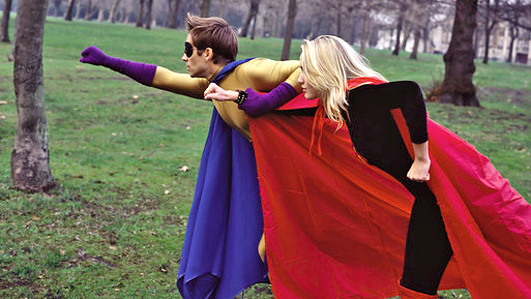This is part one of a two part series. Read part two.
“And there came a day, a day unlike any other, when Earth’s mightiest heroes and heroines found themselves united against…” – poor design, typographic crimes and the threat of confusing interfaces! Sounds great, doesn’t it? Successful teams can feed off each other’s creative drive to push innovative ideas forward resulting in amazing work. Poor team dynamics, however, can lead to Frankenstein creations. Overcoming these challenges enables a distributed team to author its own success story.

Just like the X-men who only succeed by uniting their forces, the “UX-men” (and women!) must also learn to work together in order to pull off projects that are far greater than their individual skills. The challenges and benefits of such collaborations stem from the same source: the diversity in backgrounds and perspective.
Diverse teams, with different “design upbringings,” can make collaboration difficult. Designers tend to be emotionally attached to their own work, their own ideas and – like it or not – working in a team teaches them to adjust that attachment: to take feedback, value perspective and relinquish control.
But this is far easier said than it’s done.
This two-part article looks at how you can optimize your team dynamic throughout a project. The first part will examine the steps you can take at the beginning of the collaboration to ensure all parties know their role and start off on the right foot. The following article will navigate the last stages of teamwork from surviving clashing egos to improving your design alliance from one project to the next.
The heroic mission
The foundation of any superhero design team is not something to be taken lightly. Each hero’s role should be well defined and in tune with their respective talent and skills: their super power. By clearly outlining responsibilities early on we prevent well-intentioned, do-it-alls from attempting to do, well, everything.

Next comes the most important part – the one thing that unites our heroes – the mission. Ensure the team’s objective is well defined so that all members share the same measure of success. When re-designing an existing website, for example, success can be measured by looking for an increase in conversion rates or purchases; an increase in new visitors; a decrease in the frequency of support calls; or a decrease in visits to the help page.
To that end, give your team the context necessary to understand your client’s objectives. Bring everyone around the table at least once so that they can hear the business case directly from the client and have the opportunity to ask their own questions. This not only gives the team a greater understanding of the client’s needs, it also makes them more committed to the outcome of the project.
Finally, acknowledge that one superhero may not be enough to save the day. After the goal has been established, delineate how individual teammates will work together towards attaining that goal. For instance, I can design an awesome sign up page that entices users to register using a quick and effortless process. My teammate can write equally awesome, easy-to-read copy that will inform the users why signing up is a great idea. Together, we make a great sign-up form that no user can resist!
A winning strategy
Even the best teams don’t go into battle without a strategy. Start by writing a proper project plan using your team’s best estimates. Your plan should map out all work phases and highlight the ones that can be done in parallel. Remember to make time for the often-forgotten research, testing, and presentation of your work. Further, plan time to integrate the client’s comments – especially in the beginning!
For longer projects, consider separating the process into milestones. This ensures that you get periodic sign-offs from your client throughout the project. It’s no fun discovering that the wireframes you used to build the visual design were never actually approved by the client.
…and now he wants something drastically different.
Keep your plan updated and make it visible. For longer projects, post the project plan in a public area such as a conference room. This ensures that everyone has a clear idea of where they’re headed and helps them anticipate timeline problems before they arise. For example, when faced with the addition of extra work that threatens to put a team behind schedule, teammates can collaboratively devise ways to make up for lost time by simplifying (or removing) less-important features.
If you’re looking for a more high-tech way of keeping everyone up-to-date, Freelance Switch has a great list of web-based applications that can help you set up a kick-ass project plan and to share it with your team.
Lastly, the start of a project is a good time to ensure that all superheroes are well equipped with collaboration tools and, further, that they share the same conventions for organizing and sharing their files. When we work on a solo project, we might be tempted to give into the bad habits of un-organizing our Photoshop layers or working on files without uploading them to the cloud. There’s no place for this in a successful team as someone else must be able to pick up where you left off at any time. Make sure that all team members know where to go to access all work being done on the project. Set up a file naming convention that will be common to the team. Avoid naming your files “webdesign-v2-final.psd”. Once there’s a couple “final” and “now-its-really-final” files in that folder, no one will know which one is the latest version. Either use dates in your file names or archive older items.
The saga continues…
Congratulations! We’ve united our UX-heros under one noble mission; we’ve set up the foundations of successful teamwork such as well-defined roles; and we’ve equipped our team with the necessary tools to their project survival. Come back for the sequel wherein our heroes go head-to-head in a heated ego battle! Learn useful tips for receiving and delivering constructive feedback and ensure your team reaches a happy ending. See you Thursday!
UX Booth would like to thank Jeremy Keith for the photo used as this article’s lead image.
Ready to get your feet wet in Interaction Design? In this article we touch briefly on all aspects of Interaction Design: the deliverables, guiding principles, noted designers, their tools and more. Even if you're an interaction designer yourself, give the article a read and share your thoughts.